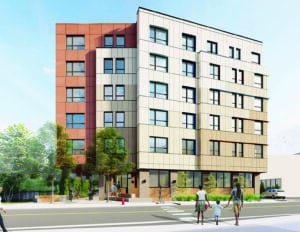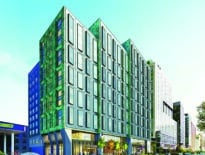
Cambridge officials are considering a proposal to expand the city’s affordable housing zoning overlay, making it easier to build fully income-restricted housing. Nonprofit Just-a-Start’s affordable housing project at 52 New St. in Alewife was approved under the existing all-affordable overlay in 2022. Image courtesy of RODE Architects
Cambridge, known for tech and biotech innovation, may soon add affordable housing policy to that list. The city has seen early success with its affordable housing zoning overlay, adding several hundred new affordable homes to the pipeline in just a few years. Now, the city seeks to further scale affordable housing production to better address its residents’ needs.
Cambridge may be a victim of its success. It has added an astounding 45,000 jobs since 1980, but housing production has fallen short, with only 13,000 homes built in that time period and the city’s affordable housing waitlist swelling to 21,000 people.
Local housing advocates and policymakers have highlighted the city’s restrictive and exclusionary zoning laws as a core reason for this lack of housing production. Like many Massachusetts municipalities, Cambridge has failed to update biased zoning decisions of the past to meet its present needs. In addition, skyrocketing land costs mean that available affordable housing funds – highly competitive and very limited – don’t go as far.
How Overlay Worked
True to its name, the affordable housing overlay revised zoning for the entire city, making it possible to build multifamily affordable housing in any Cambridge neighborhood. The AHO provides a streamlined approval process – and gave affordable housing a height advantage to better compete with other land uses.
The AHO reduces costs in part by eliminating parking minimums, an element that met with such acclaim that the Cambridge City Council voted last year to end parking minimums for all new construction, becoming the first municipality in Massachusetts to do so.
The AHO also brings certainty to the municipal approval process. While the Cambridge Planning Board provides input based on the city’s design guidelines for the overlay, proposals under the overlay move forward as-of-right. When more housing is allowed citywide and permitting barriers are reduced, affordable housing proposals have an easier path to qualifying for key public funding necessary to build.
 Remaining Roadblocks to Production
Remaining Roadblocks to Production
While the AHO removed these hurdles for housing developed under its auspices, other plans for affordable housing have still met insurmountable resistance. A recent Chapter 40B proposal to build affordable housing at 2072 Mass. Ave., in the heart of Porter Square, had the support of seven city councilors, yet still failed. The parcel’s zoning was too restrictive – despite its location on Cambridge’s busiest street, a stone’s throw from the T – and the Board of Zoning Appeals declined to provide zoning relief.
Similarly, Cambridge’s Affordable Housing Trust has looked into buying a number of local sites, but without assurances of higher density, they – and the affordable homebuilders excited to build more in Cambridge – still cannot make competitive bids. Most AHO developments to date have been on sites that were already owned by local affordable housing nonprofits or the Cambridge Housing Authority.
Now, four of Cambridge’s nine city councilors have proposed expanding the AHO to allow taller buildings in certain squares and corridors. A Better Cambridge strongly supports this plan to right-size the AHO and get the density we desperately need.

Rebecca Schofield
25 Stories of Transit-Oriented Housing
This current proposal provides for more 100 percent affordable housing in all neighborhoods of Cambridge: up to 13 stories of affordable housing along “AHO corridors,” a set of listed streets spanning the city, including Mass. Ave, Memorial Drive, Cambridge Street and Mount Auburn Street.
The proposal allows even taller buildings in “AHO squares” – up to 25 stories of transit-oriented housing in Central, Harvard and Porter Squares as well as several parcels adjacent to the new Union Square T station, in the shadow of Boynton Yards. This, and other upcoming commercial developments in neighboring Somerville, will place further pressure on housing affordability in both cities. We need to expand the AHO before these current development pressures get more extreme.
AHO expansion adds greater flexibility for open space as well, as site plans that provide extra open space will gain additional density through height instead of through larger footprints.
In Greater Boston, we still regularly see proposals to build affordable housing held hostage by so-called “neighborhood defenders,” NIMBYs with the privilege to attend endless strings of public meetings. These voices do not represent the majority of residents who strongly support affordable housing. Yet prior to passage of the overlay, proposals to build affordable housing in Cambridge routinely faced uphill battles for approval, and many proposals never left the drawing board due to fears of angry opposition.
Expanding the AHO to allow taller buildings will send an unmistakable message: Cambridge will keep innovating until we solve our affordable housing crisis.
Justin Saif and Rebecca Schofield are two of the co-chairs of advocacy group A Better Cambridge.






